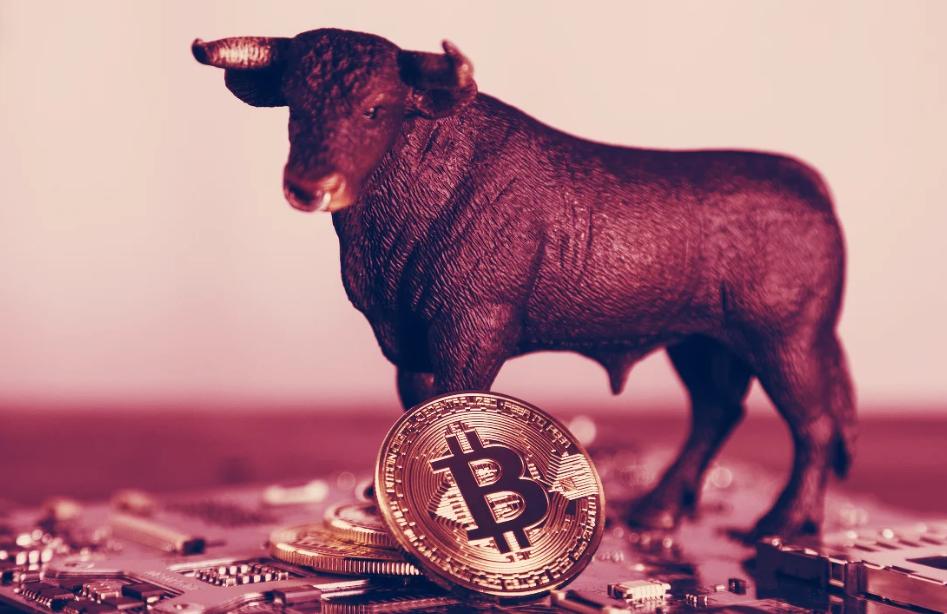ARK Invest: Bitcoin, a Unique Hedge Asset
Original Title: Bitcoin: A Unique Risk-Off Asset?
Author: Yassine Elmandjra, Head of Digital Assets at ARK Invest
Translated by: Luffy, Foresight News
Since the global financial crisis of 2008, trust in governments and financial institutions has declined. Subsequent events, such as the European sovereign debt crisis, the Federal Reserve's response to COVID-19, and the collapse of major regional banks in the United States, have exposed the drawbacks of relying on centralized institutions.
As the impact of technological innovation accelerates, the decline in trust has led people to question the effectiveness of traditional safe-haven assets in protecting modern portfolios. Has the risk of government bonds decreased following events like the European sovereign debt crisis? Has the effectiveness of physical gold as a hedge in the digital economy diminished? Does the inconsistency of Federal Reserve policies threaten the dollar's status as a reserve currency? Traditional safe-haven assets may play a role in portfolio construction, but their limitations give investors reason to reassess the so-called safe-haven assets.
While the "risk appetite" and "risk aversion" characteristics of traditional assets are mutually exclusive, Bitcoin blurs the distinction between the two. Its revolutionary technology and novelty represent risk appetite, while its absolute scarcity as a monetary asset and its role as a "nominal tool" represent risk aversion.
Bitcoin presents an interesting paradox: with its groundbreaking technology, it can effectively hedge against economic uncertainty and potentially achieve exponential growth.

Source: ARK Investment Management LLC, 2024
Bitcoin was born in 2008, initially intended to address the global financial crisis. Today, it has evolved from a fringe technology into a new asset class worthy of institutional allocation. As the network matures, investors may seriously evaluate Bitcoin's value as a safe-haven asset.
Bitcoin as a Safe-Haven Asset
Although Bitcoin's explosive growth and price volatility have led many investors and asset allocators to view it as a risk asset, we believe that the Bitcoin network embodies safe-haven characteristics, enabling financial sovereignty, reducing counterparty risk, and enhancing transparency.
Bitcoin is the first digital, independent, global, rule-based monetary system in history. By design, its decentralization should mitigate the systemic risks of the traditional financial system, which relies on centralized intermediaries and human decision-makers to establish and enforce rules. The uppercase "B" Bitcoin refers to a financial network that facilitates the transfer and custody of lowercase "b" bitcoin (a scarce digital currency asset).
We believe Bitcoin is the purest form of currency ever created. It possesses the following characteristics:
A digital, commodity-like, nominal asset.
A scarce, liquid, divisible, portable, transferable, and fungible asset.
An auditable and transparent asset.
An asset that can be fully matched by ownership, with no liability or counterparty risk custodianship.
Importantly, Bitcoin's attributes stem from the Bitcoin network operating on open-source software. While many institutions coordinate functions within the traditional financial system, Bitcoin operates as a single entity. Bitcoin does not rely on central banks, regulatory agencies, or other government decision-makers; instead, it relies on a global network to enforce rules, transforming the execution method from manual, private, and opaque to automated, public, and transparent.
Given its technological foundation, Bitcoin holds a unique position relative to traditional safe-haven assets, as shown below.
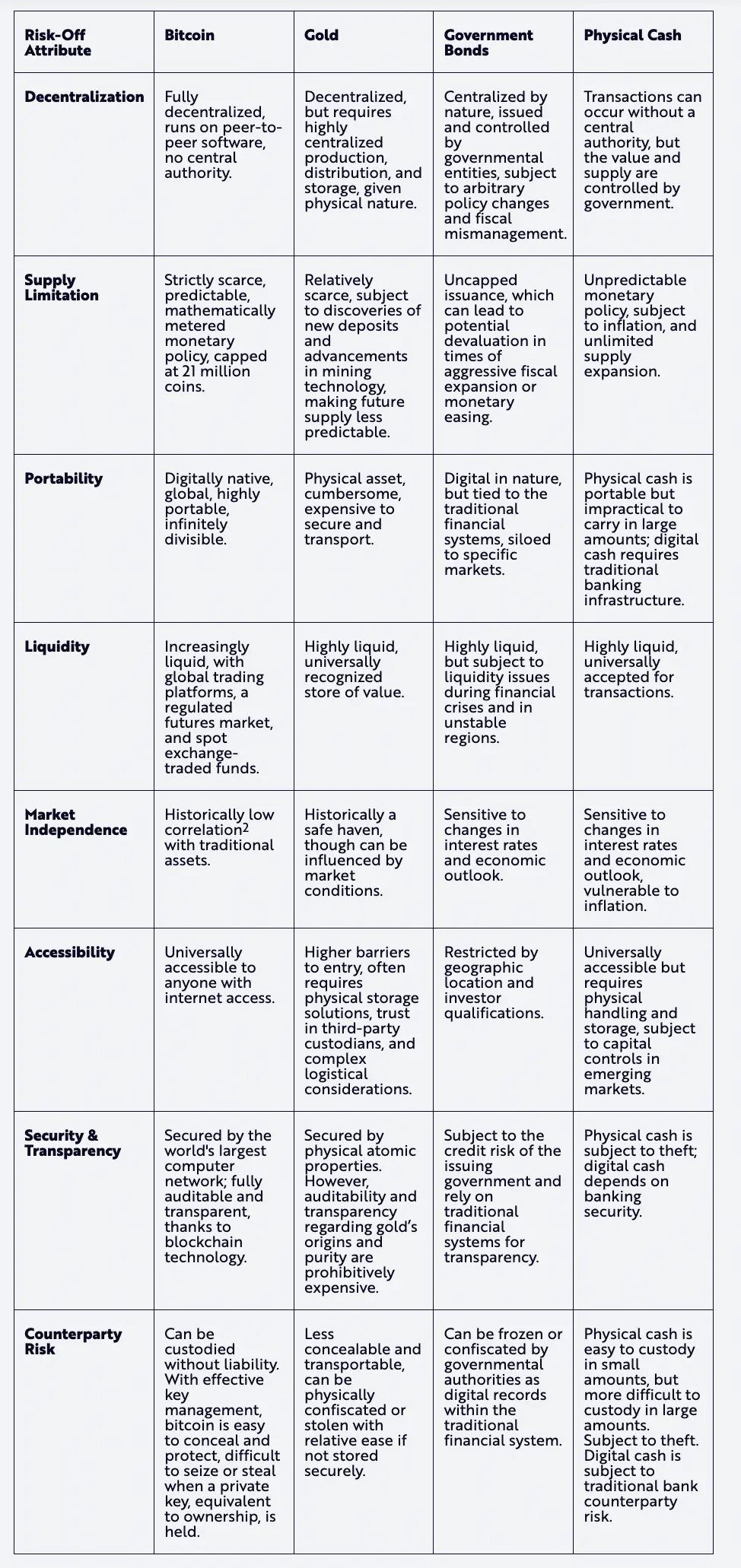
Source: ARK Investment Management LLC, 2024
Relative Performance of Bitcoin
As an emerging asset, Bitcoin's speculative characteristics and short-term volatility have garnered significant attention. Fifteen years after its inception, Bitcoin's market capitalization has surpassed $1 trillion, enhancing its purchasing power while maintaining independence.
In fact, both in the short term and long term, Bitcoin has outperformed all other major asset classes. Over the past seven years, Bitcoin's annualized return has approached 60%, while the average return of other major assets has been only 7%, as illustrated below.
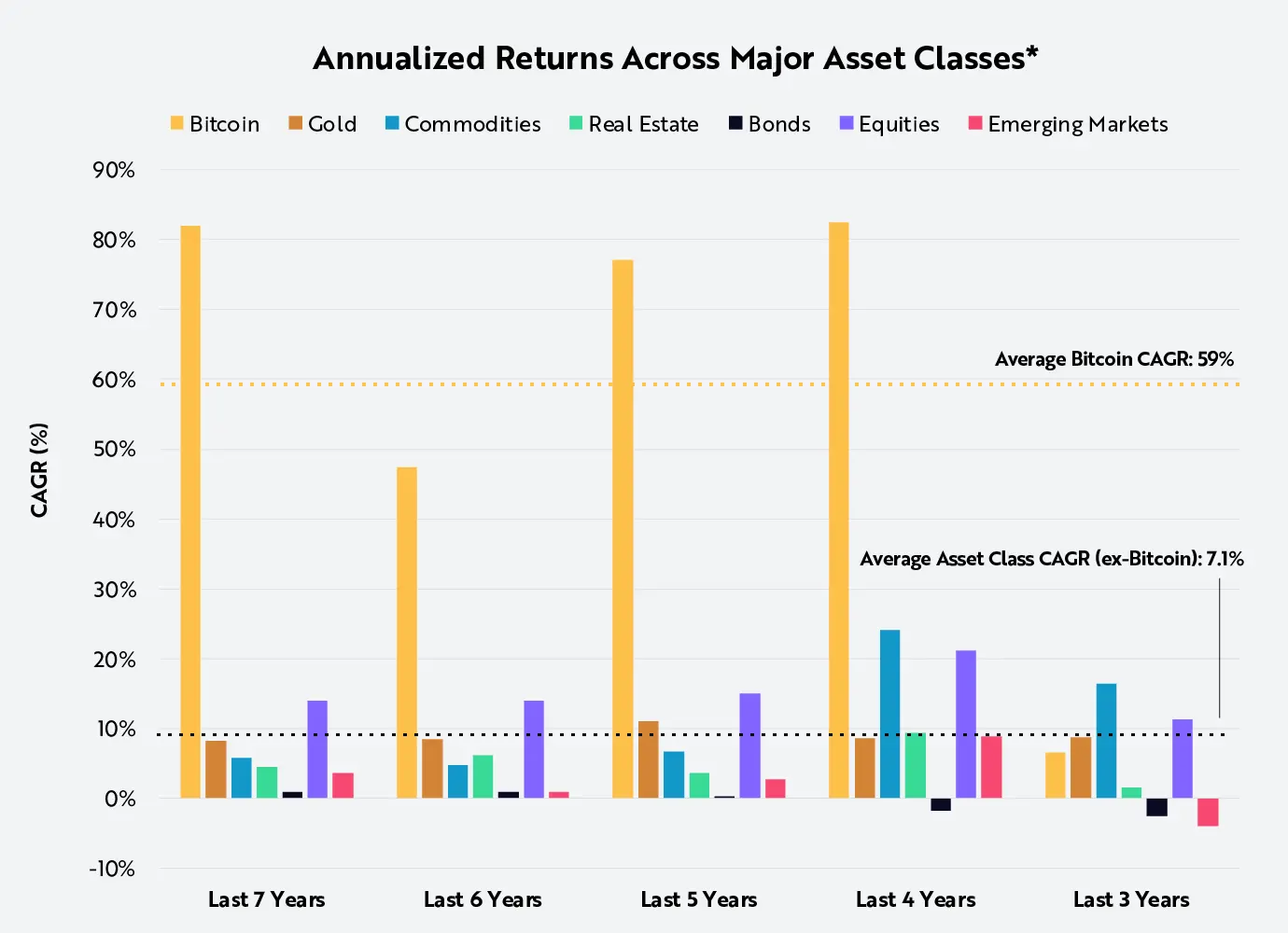
Source: ARK Investment Management LLC, 2024, based on data and calculations from PortfolioVisualizer.com, Bitcoin price data from Glassnode, as of March 31, 2024
Importantly, since Bitcoin's inception, investors who have held it for five years have made a profit, regardless of when they purchased it, as shown below.

Source: ARK Investment Management LLC, 2024, based on data from Glassnode as of December 31, 2023
In contrast, traditional safe-haven assets like gold, bonds, and short-term U.S. Treasury bills have lost 99% of their purchasing power over the past decade, as shown below.
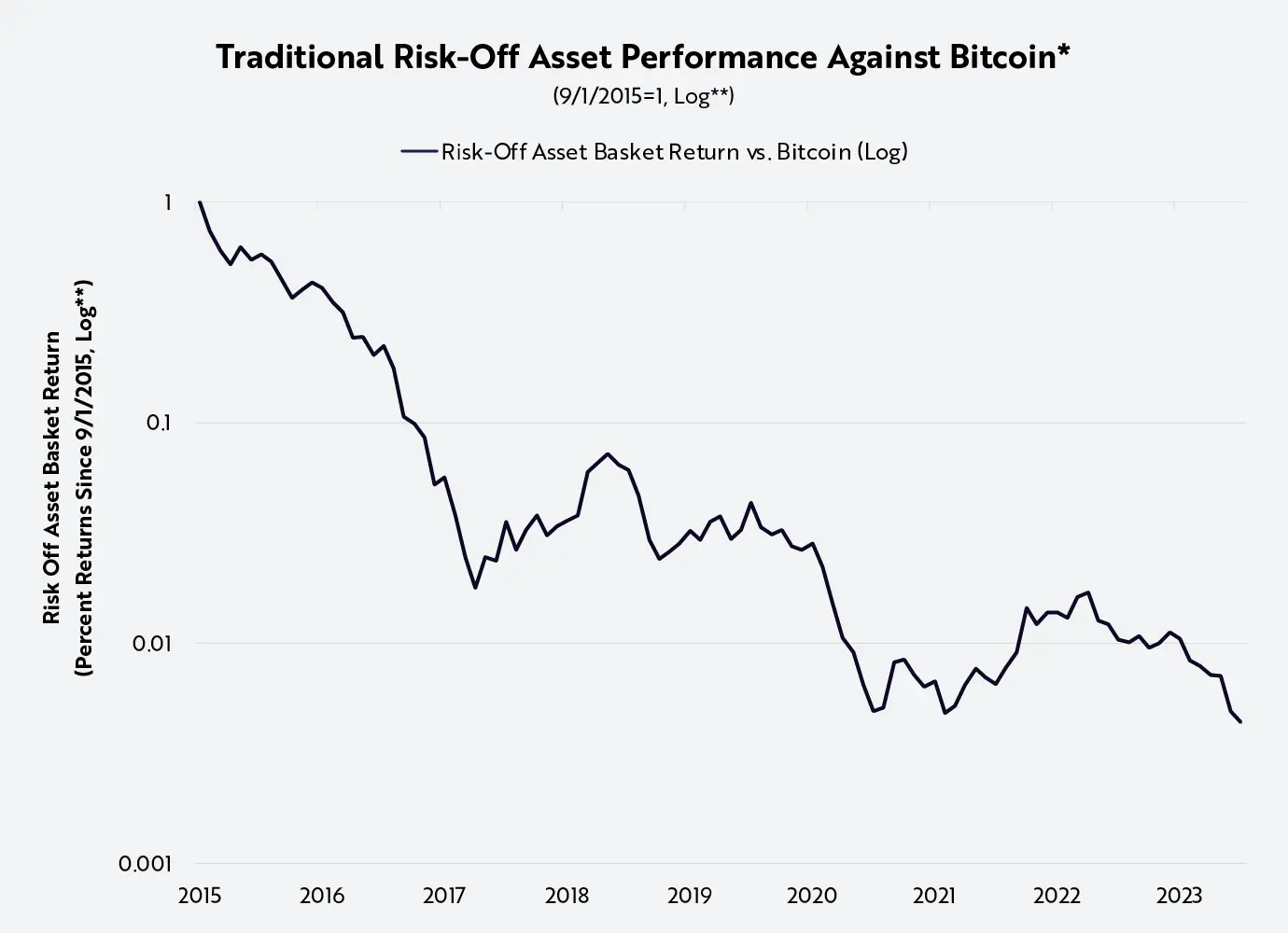
Source: ARK Investment Management LLC, 2024, based on data from PortfolioVisualizer and Glassnode as of March 31, 2024
Is Bitcoin's Volatility Too High to Be a Safe-Haven Asset?
Paradoxically, Bitcoin's volatility is a function of its monetary policy, highlighting its credibility as an independent monetary system. Unlike modern central banks, Bitcoin does not prioritize price or exchange rate stability. Instead, by controlling the growth of Bitcoin's supply, the Bitcoin network prioritizes the free flow of capital. Thus, Bitcoin's price is a function of demand relative to supply—this explains its volatility.
Nevertheless, Bitcoin's price volatility has decreased over time, as shown below:
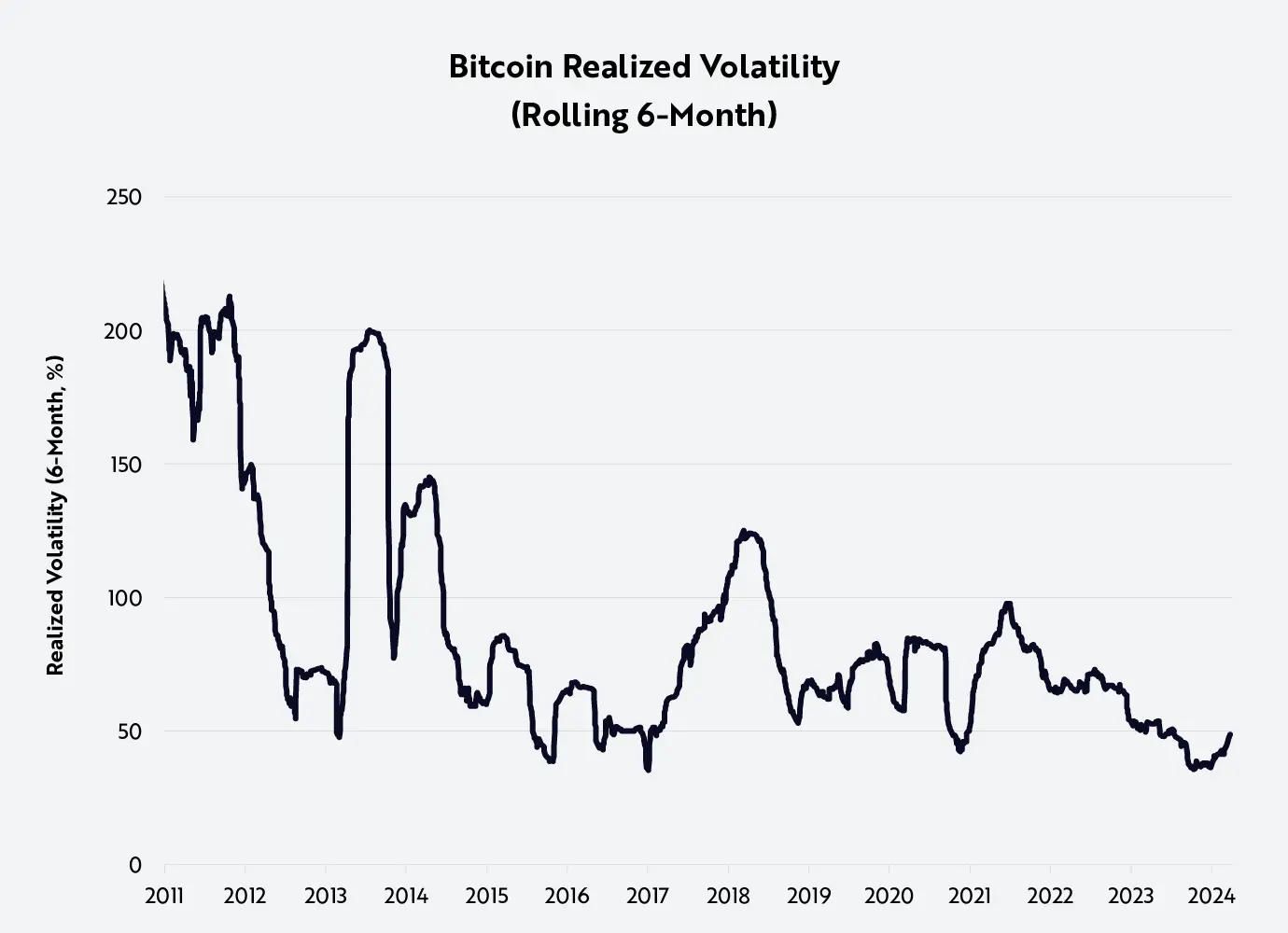
Source: ARK Investment Management LLC, 2024, based on data from Glassnode as of March 31, 2024
Why has Bitcoin's price volatility decreased over time? As Bitcoin's adoption rate continues to rise, its marginal demand relative to its total network value has decreased, thereby reducing the magnitude of its price fluctuations. All else being equal, an additional $1 billion in demand within a $10 billion network value would have a greater impact on Bitcoin's price than $1 billion would have on a $1 trillion network value. Importantly, against the backdrop of significant price increases, volatility should not hinder Bitcoin's role as a store of value.
Perhaps a more relevant metric to demonstrate Bitcoin's role in preserving capital and purchasing power is its market cost basis. While market capitalization aggregates the value of all circulating bitcoins at current prices, the market cost basis values each bitcoin at its last transaction price. The cost basis can more accurately measure changes in purchasing power. The fluctuations in cost basis are less pronounced than price fluctuations, as shown below. For example, while Bitcoin's market capitalization fell by approximately 77% from November 2021 to November 2022, its cost basis only declined by 18.5%. Today, Bitcoin's cost basis trading price has reached an all-time high, exceeding the market peak of 2021 by 20%.
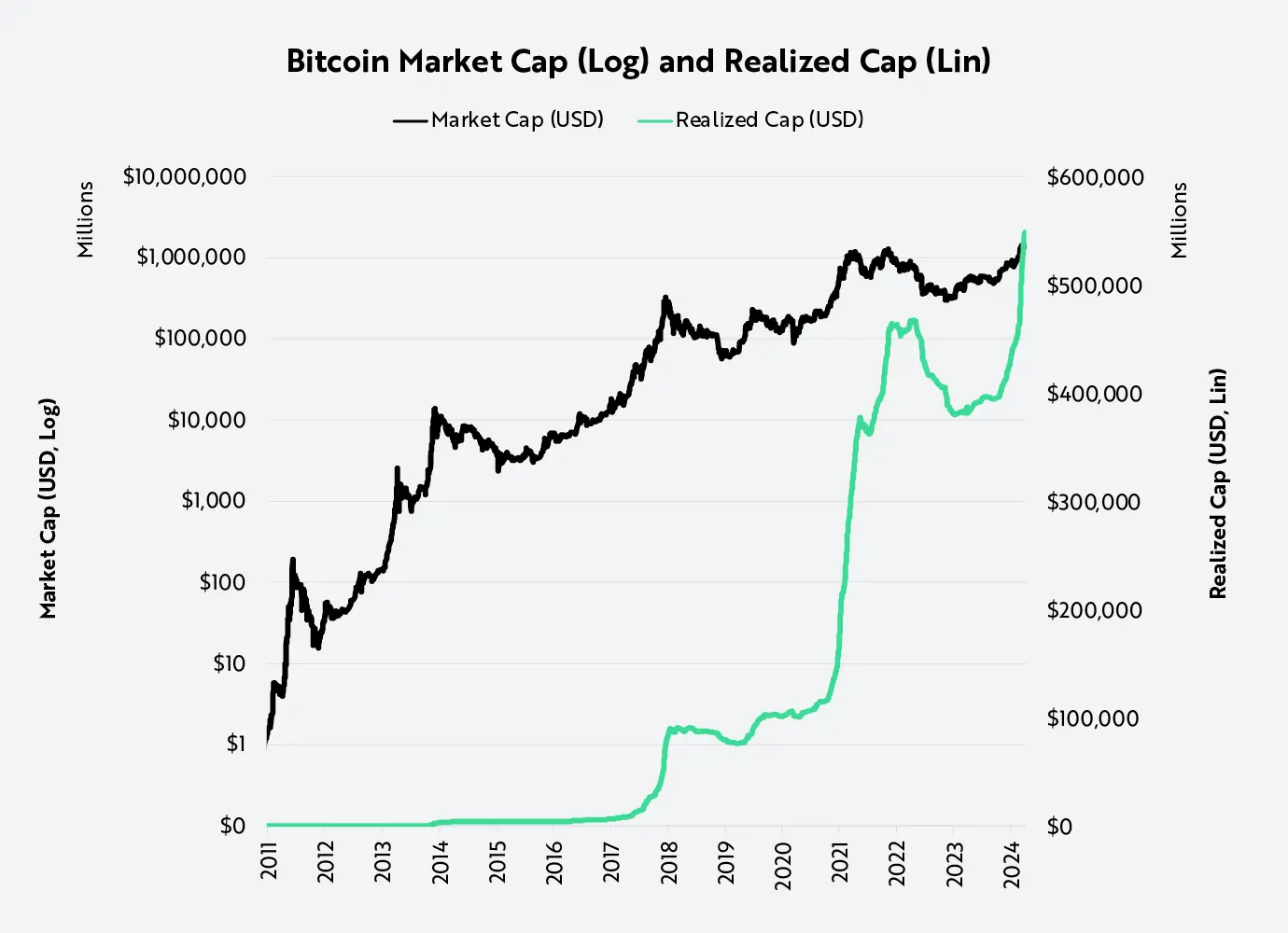
Source: ARK Investment Management LLC, 2024, based on data from Glassnode as of March 31, 2024
Bitcoin's Independence from Other Asset Classes
Low Correlation
Another reason Bitcoin is suitable as a safe-haven asset is its low correlation with the returns of other asset classes. Bitcoin is one of the few assets that consistently exhibits low correlation, as shown below. Between 2018 and 2023, the average correlation of Bitcoin returns with traditional asset classes was only 0.27. Importantly, the correlation between bonds and gold (traditionally considered safe-haven asset classes) is relatively high at 0.46, while the correlation of Bitcoin returns with gold and bond returns is 0.2 and 0.26, respectively.
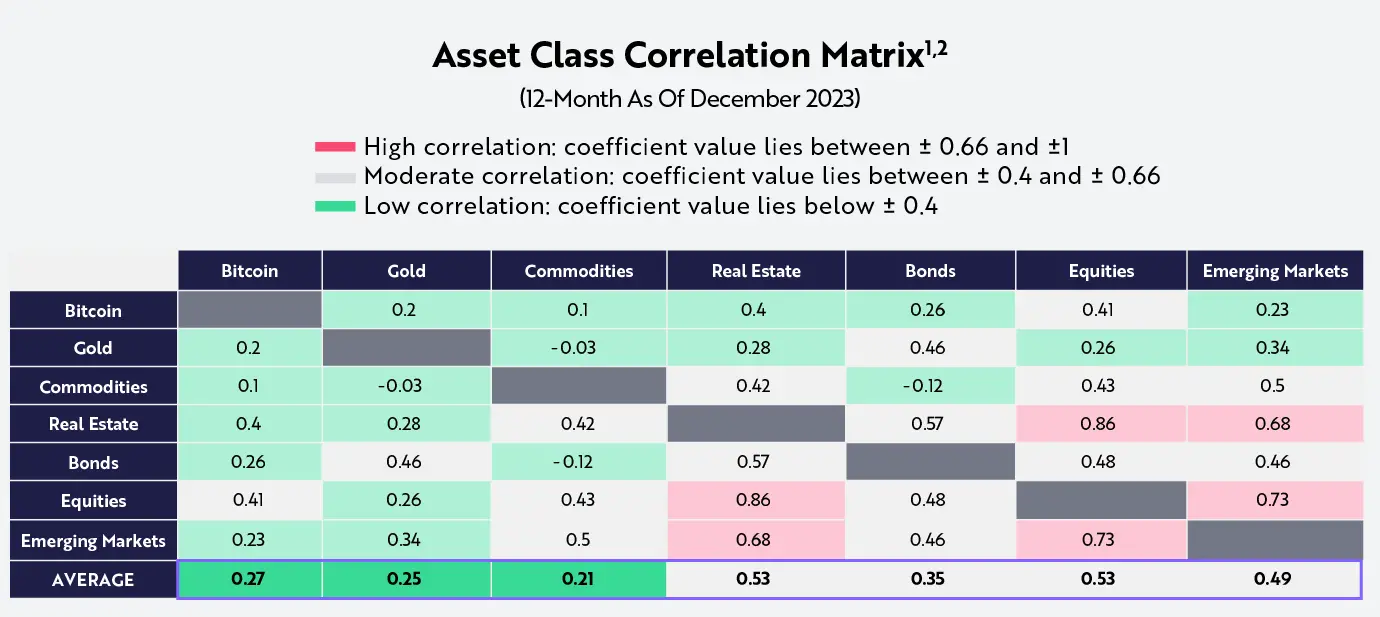
Source: ARK Investment Management LLC, 2024, based on data and calculations from PortfolioVisualizer.com, Bitcoin price data from Glassnode, as of December 31, 2023
Adapting to Changing Interest Rate Policies
Furthermore, comparing Bitcoin's price with the federal funds rate reveals its resilience in different interest rate and economic environments, as shown below. Importantly, Bitcoin's price has surged significantly under both high and low interest rate regimes, as illustrated below.

Source: ARK Investment Management LLC, 2024, based on data from FRED and Glassnode as of March 31, 2024
Over the past decade, Bitcoin's price has performed well during risk-off periods. As of the writing of this article, Bitcoin's price has risen with each crisis event, as shown below.
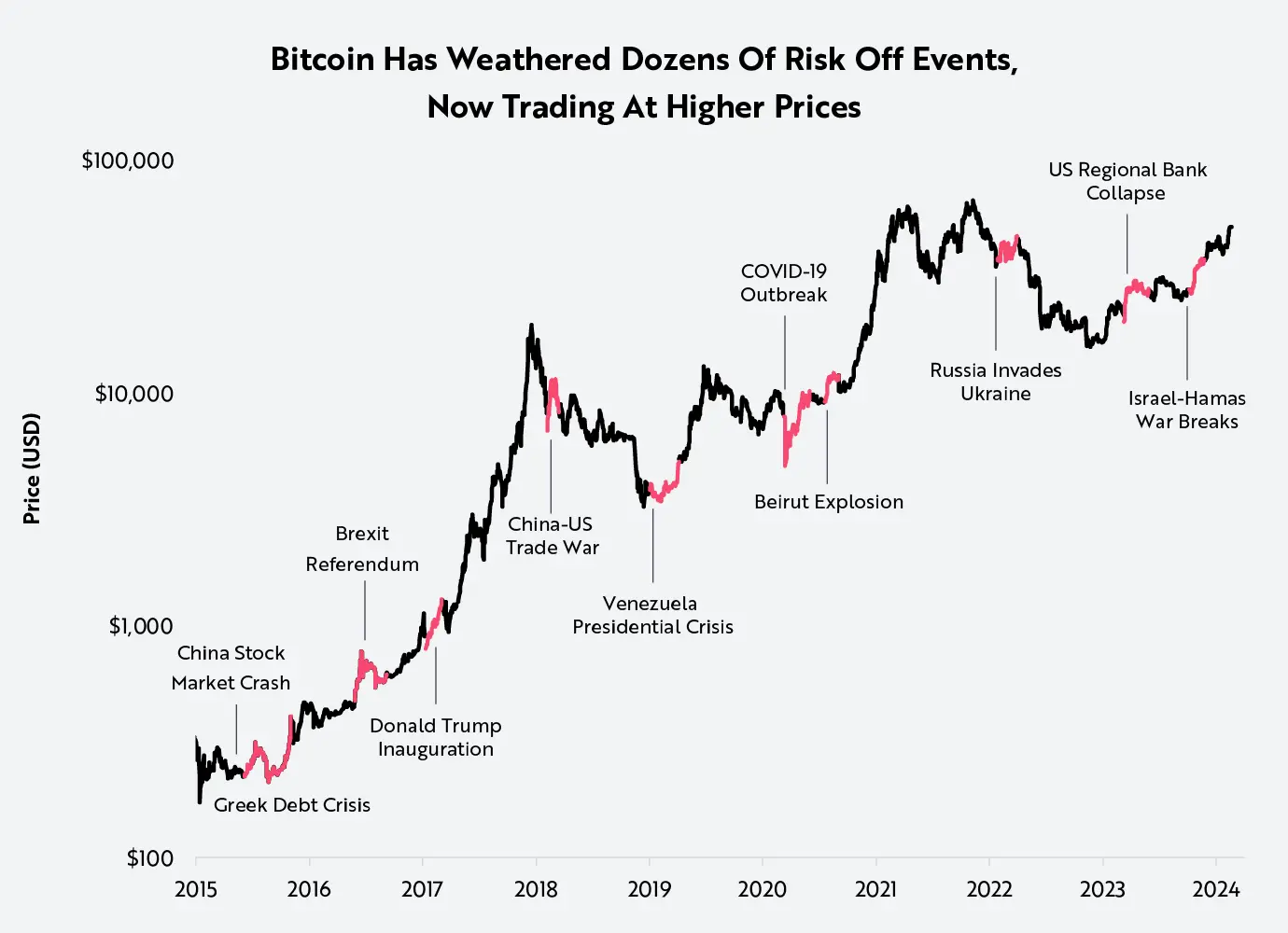
Source: ARK Investment Management LLC, 2024, based on data from Glassnode as of March 31, 2024
Bitcoin's performance during the regional banking crisis is a notable example. In early 2023, during the historic collapse of U.S. regional banks, Bitcoin's price surged by over 40%, highlighting its role in hedging counterparty risk, as shown below.
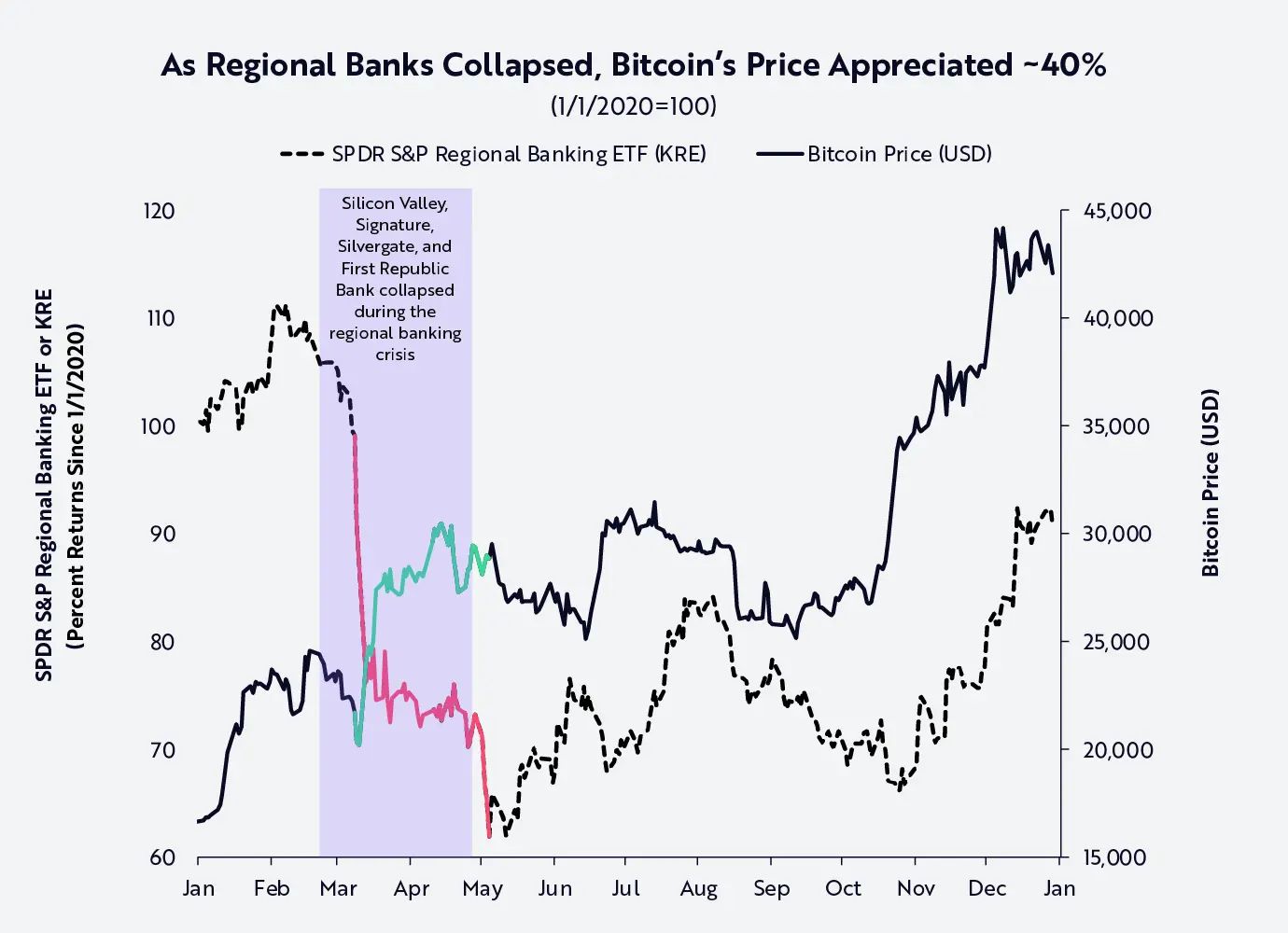
Source: ARK Investment Management LLC, 2024, based on data from Bloomberg and Glassnode as of December 31, 2023
While Bitcoin has experienced downturns, these setbacks have been industry-specific and unique. They include the Mt. Gox exchange hack in 2014, the initial coin offering (ICO) bubble in 2017, and the collapse of FTX due to fraud in 2022. In each cyclical downturn, Bitcoin has proven its anti-fragility.
Looking Ahead
In its brief history, Bitcoin has gained significant status as a safe-haven asset but remains undervalued. As the global economy continues to shift from the physical to the digital realm, the use of Bitcoin's global decentralized monetary system should continue to increase, potentially allowing Bitcoin to rival traditional safe-haven assets. Recent events have increased this possibility, such as the U.S. approval of a spot Bitcoin ETF, the adoption of Bitcoin as legal tender by nation-states like El Salvador, and companies like Block, Microstrategy, and Tesla allocating Bitcoin reserves. Bitcoin currently has a market capitalization of approximately $1.3 trillion, while the market capitalization of fixed-income assets reaches $130 trillion, suggesting that global safe-haven assets are maturing and on the verge of disruption.
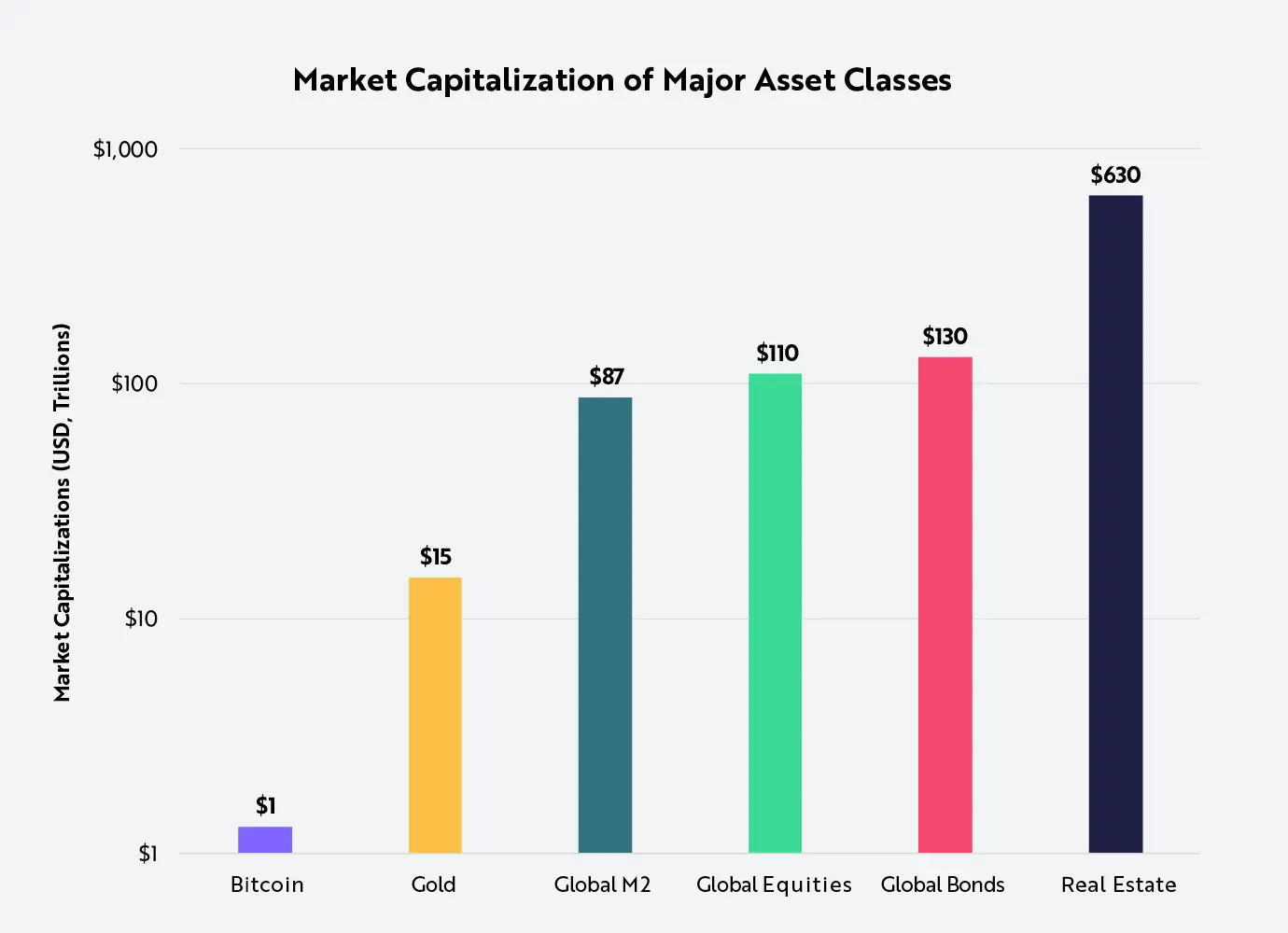
Source: ARK Investment Management LLC, 2024, based on data from Glassnode, VisualCapitalist, Statista, Macromicro.me, and Companiesmarketcap.com as of March 31, 2024
Conclusion
Bitcoin is a relatively new asset class, and the Bitcoin market is fast-paced and full of uncertainty. Bitcoin is largely unregulated, and compared to regulated asset classes, investing in Bitcoin may be more susceptible to fraud and manipulation. Bitcoin faces unique and significant risks, including substantial price volatility, lack of liquidity, and theft.
Bitcoin's price is highly volatile, influenced by actions and statements from influential figures and the media, changes in Bitcoin supply and demand, and other factors. These make it challenging for Bitcoin to maintain its value over the long term.



